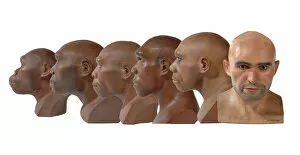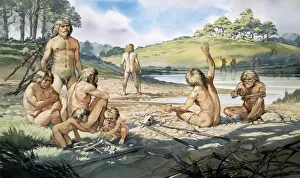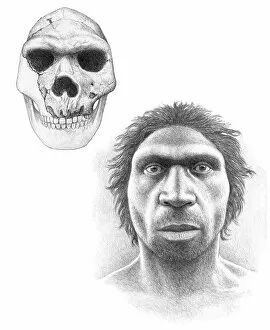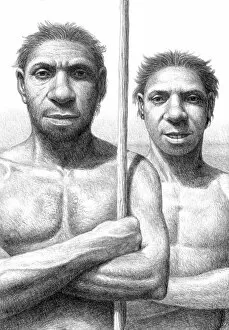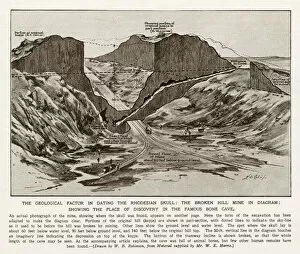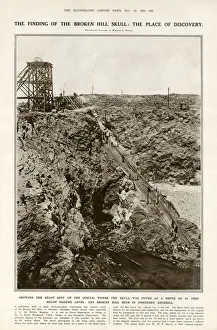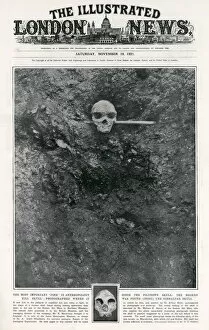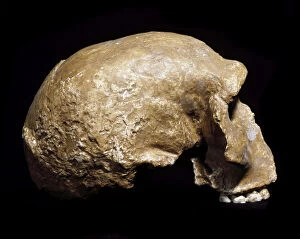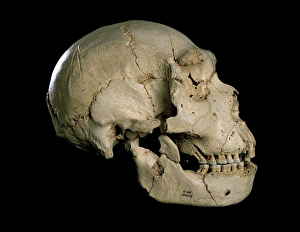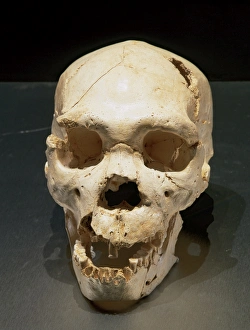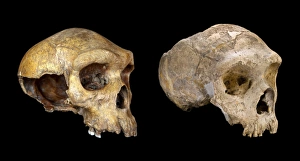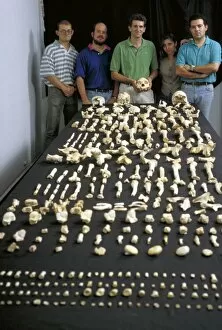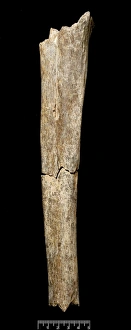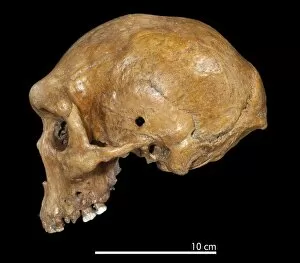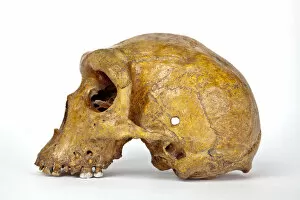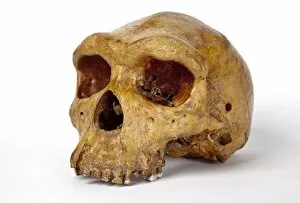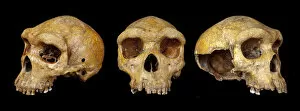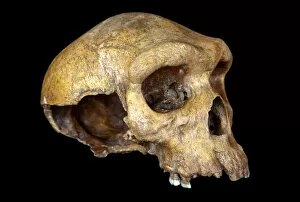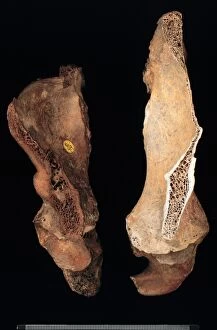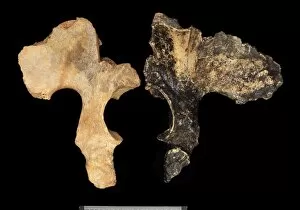Heidelbergensis Collection
Heidelbergensis is an extinct species of hominid mammal that lived in Africa, Europe
Choose a picture from our Heidelbergensis Collection for your Wall Art and Photo Gifts
143 items
All Professionally Made to Order for Quick Shipping
-
Heidelbergensis Collection
Heidelbergensis is an extinct species of hominid mammal that lived in Africa, Europe, and western Asia during the Middle Pleistocene period (600,000 to 200,000 years ago), and is considered to be a direct ancestor of both Homo sapiens and Neanderthals, a large-bodied species with a brain size larger than that of Homo erectus but smaller than modern humans. Its anatomy was similar to that of modern humans in many ways, including its bipedalism and the presence of body hair. The most distinguishing feature was its large face with prominent brow ridges. This species likely used stone tools for hunting and gathering food as well as for making clothing from animal hides, and is possible that they also had some form of language or communication system as evidenced by their burial practices which suggest they may have had some form of belief system or religion.
+
Our beautiful pictures are available as Framed Prints, Photos, Wall Art and Photo Gifts
The Heidelbergensis collection from Media Storehouse features a range of stunning wall art, framed prints, photo prints, canvas prints, jigsaw puzzles and greeting cards showcasing the fascinating hominidae mammal species. These animals are believed to have lived in Africa around 700,000 years ago and were known for their impressive physical characteristics such as large brains and robust bodies. Our collection includes images of reconstructed skulls and bones of these ancient creatures as well as illustrations depicting what they may have looked like in their natural habitat. The artwork is available in various sizes and formats to suit different preferences. Whether you're a fan of paleontology or simply appreciate beautiful artwork, the Heidelbergensis collection from Media Storehouse is sure to impress. It's an excellent way to add some unique decor to your home or office while also learning about one of the most intriguing species that ever walked on Earth.
+
What are Heidelbergensis (Hominidae Mammals Animals) art prints?
Heidelbergensis art prints are high-quality reproductions of original artwork featuring this extinct species of human. Heidelbergensis lived in Africa, Europe, and possibly Asia between 600,000 and 200,000 years ago. They were known for their large brains and robust physical features. The art prints available from Media Storehouse showcase the beauty and complexity of these ancient creatures through stunning illustrations and photographs. These prints are perfect for anyone interested in anthropology or natural history, as well as those who appreciate fine art. Whether you're looking to decorate your home or office with a unique piece of history or want to give a thoughtful gift to someone special, Heidelbergensis art prints offer something truly special. With a range of sizes and styles available, there's sure to be a print that fits your needs perfectly.
+
What Heidelbergensis (Hominidae Mammals Animals) art prints can I buy from Media Storehouse?
We offer a wide range of Heidelbergensis art prints that capture the essence and beauty of these ancient hominidae mammals. These prints showcase various aspects of Heidelbergensis, including their physical features, habitats, and behaviors. You can choose from a variety of styles such as black and white photography or colorful illustrations to suit your personal taste. Some popular options include detailed illustrations depicting the anatomy and skeletal structure of Heidelbergensis, while others feature stunning photographs showcasing their natural habitat in all its glory. Additionally, there are also artistic renditions that depict these fascinating creatures in action - hunting prey or interacting with one another. Whether you're looking for educational resources or simply want to add some unique decor to your home or office space, we have something for everyone. With high-quality printing techniques used on premium materials like canvas or fine art paper, you can be sure that your chosen print will look stunning for years to come.
+
How do I buy Heidelbergensis (Hominidae Mammals Animals) art prints?
To buy Heidelbergensis art prints from Media Storehouse, you can browse our collection of Hominidae mammal animals on their website. Once you have found the print that you like, simply add it to your cart and proceed to checkout. You will be prompted to enter your shipping and payment information before submitting your order. We offer a wide range of sizes for their art prints, so make sure to select the size that best fits your needs. We also offer different paper options such as matte or glossy finishes. If you have any questions about purchasing Heidelbergensis art prints from Media Storehouse, they have a customer service team available to assist you. Simply reach out through their contact page or email address provided on their website. Buying Heidelbergensis art prints from Media Storehouse is a simple process that allows you to bring these fascinating prehistoric creatures into your home or office space.
+
How much do Heidelbergensis (Hominidae Mammals Animals) art prints cost?
We offer a wide range of Heidelbergensis art prints that are available for purchase. The cost of these prints may vary depending on the size and type of print you choose. We have a variety of options including canvas prints, framed prints, and poster prints to suit your preferences. Our Heidelbergensis art prints feature high-quality images that showcase the beauty and majesty of these hominidae mammals animals. Whether you're looking for a stunning piece to add to your home or office decor or searching for an ideal gift for someone special in your life who loves nature and wildlife, our collection has something for everyone. We take pride in offering affordable prices without compromising on quality so that everyone can enjoy beautiful artwork from our store. Our team is dedicated to providing exceptional customer service, ensuring that every order is handled with care and attention to detail.
+
How will my Heidelbergensis (Hominidae Mammals Animals) art prints be delivered to me?
We take pride in delivering your Heidelbergensis art prints with the utmost care and attention to detail. Your order will be printed on high-quality paper using state-of-the-art printing technology to ensure that every detail of the artwork is captured perfectly. Once your order has been processed and printed, it will be carefully packaged by our team of experts to ensure that it arrives at your doorstep in pristine condition. We use sturdy packaging materials to protect your print from any damage during transit. Your order will be delivered directly to you via a trusted courier service. You can track the progress of your delivery online using the tracking number provided once your package has been dispatched. We are committed to providing you with an exceptional shopping experience, and we strive to make sure that every aspect of our service meets or exceeds your expectations. So sit back, relax, and let us take care of everything for you.

